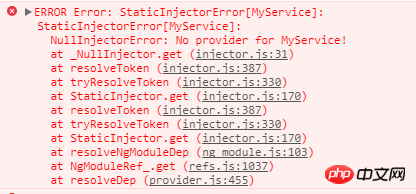Home >Web Front-end >JS Tutorial >The difference between ViewProviders and Providers in Angular
The difference between ViewProviders and Providers in Angular
- php中世界最好的语言Original
- 2018-03-19 16:52:224387browse
This time I will bring you the difference between ViewProviders and Providers in Angular. What are the precautions for using ViewProviders and Providers in Angular? The following is a practical case, let's take a look.
When usingDependency Injection (DI) in Angular, we generally use providers. In fact, we have another option to do the same thing: viewProviders.
viewProvidersAllows us to define providers that are only visible to the component's view. Below we use examples to illustrate this point in detail. Suppose we have a simple service:
// myService.service.ts
import { Injectable } from '@angular/core';
@Injectable()
export class MyService{
testIfGetService(where){
console.log('Got My Service in ' + where);
}
}This service is very simple, just print out where the service is called. Then there is a child component, which is used to project into the parent component (you will see it later):
// child.component.ts
import { Component } from '@angular/core';
import { MyService } from './myService.service';
@Component({
selector: 'vp-child',
template: `
<p>This is child!!!</p>
`
})
export class VPChild{
constructor(
private service: MyService
){
this.service.testIfGetService('child');
}
}This component injects the MyService service and calls ##testIfGetService method of #MyService, and passing in child indicates that this is called in the child component. There is another sub-component, which is used to be placed in the template of the parent component:
// viewChild.component.ts
import { Component } from '@angular/core';
import { MyService } from './myService.service';
@Component({
selector: 'vp-viewchild',
template: `
<p>This is viewChild!!!</p>
`
})
export class ViewVPChild{
constructor(
private service: MyService
){
this.service.testIfGetService('viewChild');
}
}
Here we also inject the MyService
service and call The testIfGetService method of the MyService service and pass in viewChild. Finally, the parent component:
// parent.component.ts
import { Component } from '@angular/core';
import { MyService } from './myService.service';
@Component({
selector: 'vp-parent',
template: `
<p>This is parent!!!</p>
<ng-content></ng-content>
<vp-viewchild></vp-viewchild>
`,
providers: [MyService]
})
export class VPParent{
constructor(
private service: MyService
){
this.service.testIfGetService('parent');
}
}
In the parent component, register MyService
with providers, and then call testIfGetService of MyService Incoming parent. Then use the parent component like this:
<vp-parent> <vp-child></vp-child> </vp-parent>
Run the program, and the console prints the result:
 Everything is as expected! !
Everything is as expected! !
viewProviders
instead of providers to register MyService and see what happens: <pre class="brush:php;toolbar:false">// parent.component.ts
import { Component } from '@angular/core';
import { MyService } from './myService.service';
@Component({
selector: 'vp-parent',
template: `
<p>This is parent!!!</p>
<ng-content></ng-content>
<vp-viewchild></vp-viewchild>
`,
viewProviders: [MyService] // <---
})
export class VPParent{
constructor(
private service: MyService
){
this.service.testIfGetService('parent');
}
}</pre> After this modification, run the program , and found that an error was reported:
 If the contentChild
If the contentChild
is removed, like this: <vp-parent>
<!-- <vp-child></vp-child> -->
</vp-parent>
will not report an error:
 This means that the provider registered with
This means that the provider registered with
in the parent component is not visible to contentChildren. The provider registered using providers is visible to both viewChildren and contentChildren! Additional explanation: The component will search for the provider step by step until it is found, otherwise an error will be thrown. Just like here:
<vp-parent> <vp-child></vp-child> </vp-parent>
vp-child
went up to find the provider of MyService, and found it in vp-parent. But when using viewProviders, vp-child looks up, that is, to vp-parent, but it is not found, and then goes to The parent of vp-parent was still not found (because in this example, we only registered MyService at vp-parent), and then continued to look up... ...so the boundary was not found, so an error was thrown. If you don't want this, you can use @Host to make restrictions, like this: <pre class="brush:php;toolbar:false">constructor(
@Host() private service: MyService
){}</pre> This article will not expand on @Host(). If you are interested, you can google it yourself.
I believe you have mastered the method after reading the case in this article. For more exciting information, please pay attention to other related articles on the php Chinese website!
Recommended reading:
Vue.js form input bindingWhat class definition components are there in ReactThe above is the detailed content of The difference between ViewProviders and Providers in Angular. For more information, please follow other related articles on the PHP Chinese website!
Related articles
See more- An in-depth analysis of the Bootstrap list group component
- Detailed explanation of JavaScript function currying
- Complete example of JS password generation and strength detection (with demo source code download)
- Angularjs integrates WeChat UI (weui)
- How to quickly switch between Traditional Chinese and Simplified Chinese with JavaScript and the trick for websites to support switching between Simplified and Traditional Chinese_javascript skills

